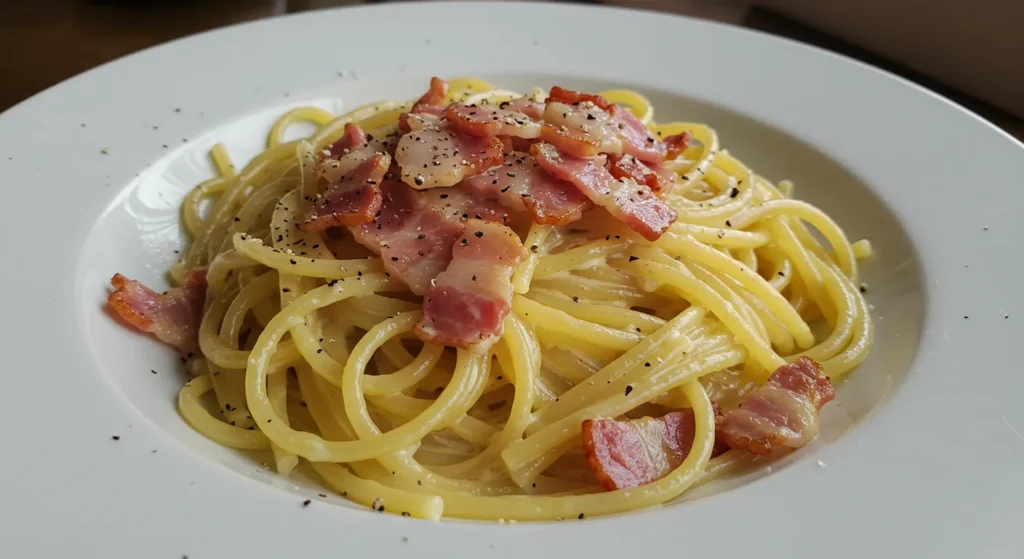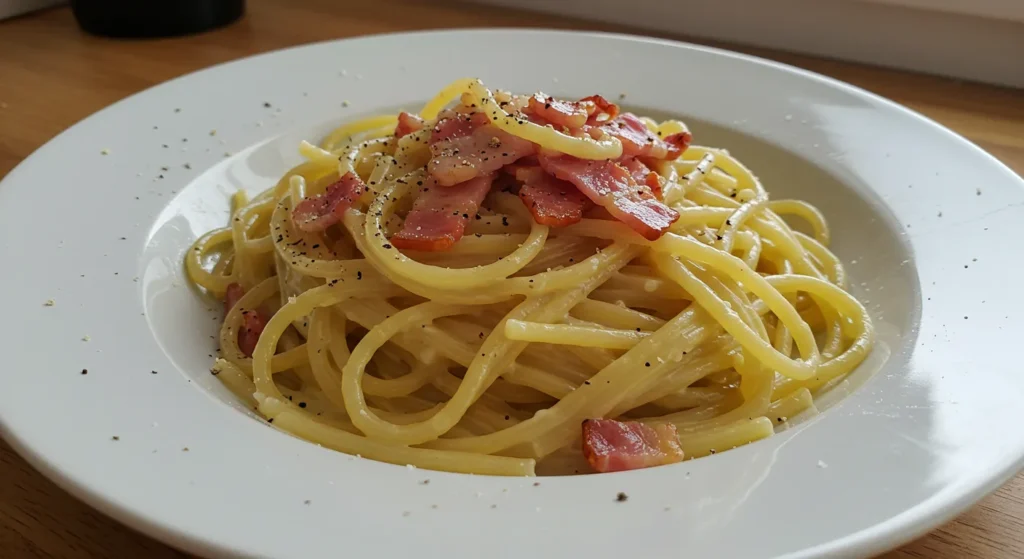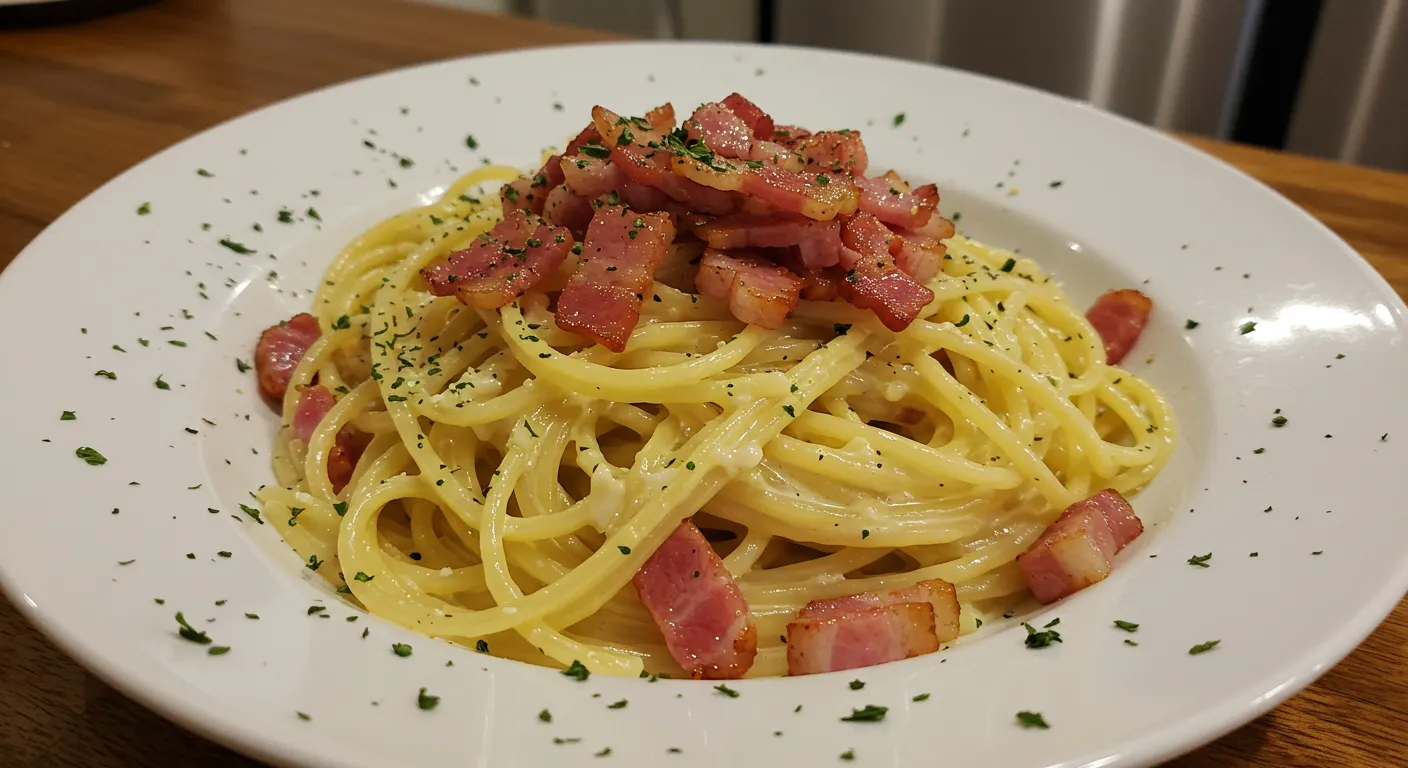
Table of Contents
My love for Italian food started in a small Roman trattoria. There, a chef made a spaghetti carbonara that amazed me. He turned simple ingredients into a creamy, luxurious dish right before my eyes.
This pasta dish is more than just food. It shows the beauty of simple Italian cooking. Spaghetti carbonara is a key part of Roman cooking. It uses a few top-quality ingredients to make a dish that’s both cozy and fancy.
In this guide, I’ll share the secrets of making real spaghetti carbonara. You’ll learn how to pick the best ingredients and make a sauce that’s just right. You’ll see how to make a pasta dish that’s truly special.
Key Takeaways
- Discover the authentic roots of traditional spaghetti carbonara
- Learn the critical techniques for creating a perfect creamy sauce
- Understand the importance of ingredient quality in Italian pasta dishes
- Explore the regional variations and historical significance of carbonara
- Master the art of balancing eggs, cheese, and cured pork
The Rich History and Origins of Carbonara
Exploring Italian cuisine reveals amazing stories. Spaghetti Carbonara is a key roman dish with deep roots. Its history shows it’s more than just food.
Roman Culinary Heritage
Rome’s food culture is tied to carbonara’s origins. Its history is complex, debunking myths. It’s not just a post-World War II dish, but has ancient roots.
- First documented recipe found in 1839
- Deeply rooted in Lazio region’s culinary traditions
- Closely related to other Roman pasta dishes like Amatriciana
The Post-War Connection
Carbonara’s story is not just about American G.I.s. It existed long before 1944. It uses local ingredients like guanciale and pecorino cheese.
“Carbonara represents more than a recipe – it’s a culinary narrative of Roman resilience and creativity.”
Etymology and Cultural Significance
The name carbonara might come from carbonaro (charcoal worker). But, we don’t have clear proof. Its evolution shows Italy’s changing food culture.
Learning about carbonara is like seeing its journey. From simple kitchens to worldwide fame, it shows true Italian food spirit.
Essential Ingredients for Authentic Spaghetti Carbonara
Making the best comfort food means knowing the key ingredients. Quality stuff is what makes creamy sauces stand out. As a home cook, I’ve found that’s true.
- Spaghetti: The perfect base for this classic recipe
- Egg yolks: Critical for creating that signature creamy texture
- Guanciale: Traditional cured pork that provides rich flavor
- Pecorino Romano cheese: Adds sharp, salty complexity
- Freshly ground black pepper: Provides a subtle kick
Each part is important for a real carbonara. When these ingredients come together, they make a dish that’s both simple and fancy.
| Ingredient | Quantity per Serving | Importance |
|---|---|---|
| Egg Yolks | 4 large | Creates creamy sauce base |
| Guanciale | ½-¾ cup | Provides authentic flavor profile |
| Pecorino Romano | 1 cup grated | Adds depth and saltiness |
| Black Pepper | ½-1 teaspoon | Enhances overall taste |
“The beauty of carbonara lies in its simplicity and the quality of its ingredients.” – Italian Culinary Tradition
Pro tip: Use fresh, top-notch ingredients to make your carbonara amazing. The right mix turns this dish into a real Italian food masterpiece.
Choosing the Perfect Pork: Guanciale vs. Pancetta vs. Bacon
Choosing the right pork is key for a great carbonara. Guanciale, pancetta, and bacon each add their own flavor. This makes the dish special.
Each pork type changes the taste and feel of your dish. Let’s look at these tasty options:
Guanciale: The Authentic Italian Choice
Guanciale is the true Italian choice for carbonara. It’s made from pig’s jowl and is very fatty. It’s seasoned with salt, pepper, and herbs, giving it a deep flavor.
- Highest fat content among cured pork options
- Aged for 3+ months
- Most authentic for traditional carbonara
Pancetta: A Flavorful Alternative
Pancetta has a pure pork taste that’s great in carbonara. It’s cured in salt and herbs, making it taste milder than guanciale.
| Characteristic | Pancetta Details |
|---|---|
| Origin | Pork belly |
| Curing Process | Salt brine, herb seasoning |
| Aging Period | Up to 4 months |
Bacon: The American Twist
Bacon adds a smoky taste to carbonara. It’s easy to find and makes a tasty twist on the classic.
“The key is understanding how each pork variety will influence your final dish’s flavor profile.” – Italian Culinary Expert
Try pancetta first for a mix of tradition and ease. Then, try guanciale for the real Italian taste.
The Secret to Perfect Eggs in Carbonara
Making the best egg-based sauce for pasta like carbonara needs skill and care. I found out that a creamy sauce is all about how you prepare the eggs.
The secret to egg-based sauces is finding the right mix of ingredients. I like to use a special egg ratio:
- 3 large egg yolks
- 1 whole egg
- Room temperature eggs for smoother mixing
Creating creamy sauces takes careful steps. Here’s what I do:
- Whisk eggs well for 2-3 minutes
- Take the pan off the heat before mixing
- Mix the sauce slowly to avoid scrambling
“The difference between a perfect carbonara and a failed attempt is often just seconds of careful technique.” – Roman Pasta Masters
Experts say keeping the right temperature is key. The pasta should be about 158°F. This cooks the eggs softly, without making them scrambled. By following these steps, you’ll get a smooth, rich sauce that sticks to the pasta well.
Cheese Selection: Pecorino Romano and Parmesan Blend
Cheese is very important in Italian cooking. It makes a simple dish like spaghetti carbonara into something special. The right cheese mix is key to a great carbonara.
I suggest mixing Pecorino Romano and Parmesan cheese for the best taste. This mix brings the true taste of Italy to your dish.
Optimal Cheese Ratios
The best mix is equal parts of each cheese. Here’s how much you need:
- 40g (1/3 cup) freshly grated Pecorino Romano
- 40g (1/3 cup) freshly grated Parmesan cheese
Grating and Incorporating Techniques
Getting the cheese right is important for a smooth sauce. Here’s how to do it:
- Use a fine grater for better mixing
- Grate cheese just before using it
- Mix it well with egg yolks
“The secret to great carbonara lies in the quality of your cheese and how you incorporate it.”
Using fresh cheese is a must. Packaged cheese just doesn’t taste the same. It’s all about the flavor and texture for a real carbonara.
Step-by-Step Spaghetti Carbonara Preparation
Making perfect pasta dishes in Italian cuisine needs care. I’ll show you how to make a creamy sauce masterpiece. It will feel like you’re in Rome.
Pasta Cooking Techniques
Choosing the right pasta is key for a real carbonara. Use top-quality spaghetti. Cook it in a big pot of salted water. Here’s what to do:
- Use 8 ounces of uncooked spaghetti
- Bring water to a rolling boil
- Cook pasta until al dente (typically 8-10 minutes)
- Reserve 1 cup of pasta water before draining
Sauce Assembly Methods
The secret to a rich carbonara is in its sauce. I’ll teach you to make a smooth sauce that covers every pasta strand:
- Whisk 2 large eggs in a big bowl
- Add 3/4 cup freshly grated Parmesan cheese
- Incorporate freshly ground black pepper
- Crisp 6 ounces of chopped pancetta in a skillet
Temperature Control Tips
Getting the right temperature is key to avoid egg scrambling. Here’s my expert tip:
- Remove pan from direct heat
- Quickly mix hot pasta with pancetta
- Gradually add egg mixture
- Stir continuously to create creamy consistency

This whole process takes about 25 minutes. It makes a dish that serves 3-4 people. Enjoy your Italian cooking adventure!
Common Mistakes to Avoid When Making Carbonara
Making perfect pasta dishes like carbonara needs care and knowledge. Even skilled cooks can make mistakes that ruin the creamy sauce. These mistakes can turn your dish into a big disappointment.
Here are the main mistakes to avoid:
- Frying eggs: This makes your carbonara into a frittata, ruining the texture
- Overcooking eggs: This makes a scrambled mess instead of a smooth sauce
- Adding unwanted ingredients like garlic or cream
- Using the wrong cheese
Keeping the right temperature is very important when making carbonara. Never pour egg mixture onto pasta while it’s on heat. This mistake scrambles the eggs and ruins the sauce.
“The key to perfect carbonara is swift, precise movements and respect for traditional techniques.” – Italian Culinary Academy
To keep the sauce creamy, chefs suggest:
- Use only ¼ to ½ cup of pasta water
- Grate pecorino romano very finely
- Work quickly when mixing hot pasta with egg mixture
- Use fresh cracked black pepper
Use only the right ingredients: two eggs, guanciale, pecorino romano, and black pepper. Don’t add too much to this simple yet amazing dish.
| Mistake | Consequence | Solution |
|---|---|---|
| Using cream | Inauthentic texture | Rely on egg yolks for creaminess |
| Incorrect cheese | Wrong flavor profile | Use pecorino romano or parmesan |
| Overcooking eggs | Scrambled texture | Remove from heat, mix quickly |
Nutritional Information and Serving Suggestions
Spaghetti Carbonara is a favorite comfort food in Italian cuisine. It’s full of flavor and good for you. Knowing its nutritional facts helps you enjoy it more.
Nutritional Breakdown
A serving of spaghetti carbonara is very nutritious. It meets your taste and health needs. Here are the main nutrients:
| Nutrient | Amount | % Daily Value |
|---|---|---|
| Calories | 200 | 10% |
| Total Fat | 5g | 6% |
| Protein | 9g | 18% |
| Carbohydrates | 29g | 11% |
Portion Size Recommendations
It’s important to control portions when making carbonara. I suggest:
- 50g serving per person
- Pair with a light salad for balance
- Limit frequency due to rich ingredients
Creative Serving Ideas
Make your spaghetti carbonara special with these ideas:
- Garnish with fresh parsley
- Add cracked black pepper
- Serve with a crisp white wine

“Enjoy carbonara as an occasional indulgence, savoring each carefully prepared bite.” – Italian Culinary Tradition
Remember, moderation is the secret to enjoying this delicious Italian pasta dish!
Conclusion
Exploring spaghetti carbonara has been fun. It’s a journey into Italian cuisine and classic recipes. This dish is more than simple; it’s a mix of tradition and creativity.
Carbonara is a celebration of cultures coming together. It’s loved for its creamy taste and rich flavors. Every cook adds their own twist, making it special.
Learning to make carbonara takes time and care. It’s about balancing eggs, cheese, and meats just right. It’s perfect for any meal, big or small.
Start your carbonara journey with open arms. Try new things and enjoy the process. It’s a dish that connects us to our culinary roots.
FAQ
What is the authentic origin of Spaghetti Carbonara?
Spaghetti Carbonara comes from Rome, not from after World War II as some think. Its exact start is a bit of a mystery. But, it’s a beloved Roman dish that grew from old Italian cooking ways.
What are the essential ingredients for a traditional Carbonara?
You need spaghetti, eggs, and cheeses like Pecorino Romano and Parmesan. Also, use guanciale, a special type of pork. Using the best ingredients makes a true Carbonara.
Can I substitute guanciale with other types of pork?
Yes, you can use pancetta or bacon instead of guanciale. Each will change the taste a bit. Pancetta is closest, while bacon adds a smoky flavor.
How do I prevent the eggs from scrambling when making Carbonara?
Mix eggs with cheese and add hot pasta water slowly. Then, take the pan off the heat. Stir fast to make a creamy sauce without scrambled eggs.
Is Carbonara a healthy dish?
Carbonara is rich and full of calories and fat. It’s best to enjoy it in small amounts. It has protein from eggs and cheese, but also a lot of saturated fat.
What’s the difference between Pecorino Romano and Parmesan?
Pecorino Romano is made from sheep’s milk and tastes sharp and salty. Parmesan, from cow’s milk, is milder and nuttier. Traditional Carbonara uses both.
Can I make a vegetarian version of Carbonara?
Yes, you can make a veggie version by leaving out the guanciale or using fake bacon. But, it won’t taste like the real thing.
What type of pasta works best for Carbonara?
Spaghetti is the top choice, but linguine or bucatini work too. Pick fresh, high-quality pasta for the best sauce.
How important is the pasta water in making Carbonara?
Pasta water is key for the right sauce. It makes the eggs and cheese mix smoothly, sticking to the pasta perfectly.

